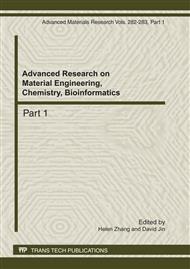p.388
p.395
p.399
p.403
p.407
p.412
p.417
p.421
p.425
Preparation of Pruning Mulberry Shoot-Based Activated Carbon by ZnCl2 Activation
Abstract:
This paper reports the preparation of activated carbon from a new type of agricultural biomass materials, pruning mulberry shoot, by ZnCl2 activation. The experiments in this study vary the parameters of ZnCl2 activation procedures, such as concentration and impregnation ratio of the activating agent, temperature and time of chemical activation. The experimental results indicated that with a ZnCl2 concentration of 50%, an impregnation ratio of 2:1, an activation temperature of 850 °C, and an activation time of 90 min, the activated carbon with better iodine and MB adsorption capacity were 1422.40 mg/g and 163.54mg/g, respectively. Therefore, the optimal preparation process of activated carbon from pruning mulberry shoot was successfully achieved by using single-factor method in this study, which can be used as adsorbents for various environmental applications.
Info:
Periodical:
Pages:
407-411
Citation:
Online since:
July 2011
Price:
Сopyright:
© 2011 Trans Tech Publications Ltd. All Rights Reserved
Share:
Citation:


